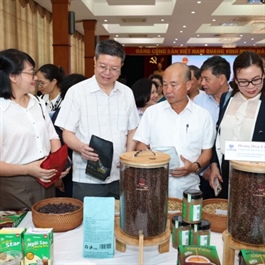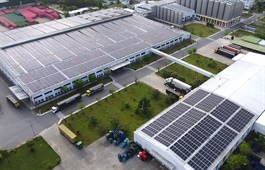FTAs and green development remain key drivers of export
FTAs and green development remain key drivers of export
Minister of Industry and Trade Nguyễn Hồng Diên talked to the Vietnam News Agency (VNA) about 2024 - a year the economy faced a mix of challenges, but also saw the country making the most out of Free Trade Agreements (FTAs), especially the new-generation ones, to find opportunities.

Minister of Industry and Trade Nguyễn Hồng Diên was interviewed by Vietnam News Agency (VNA) about 2024, a year Việt Nam’s economy faced a mix of challenges, both global and national.
The country was also severely affected by natural disasters, particularly Typhoon No. 3 (Yagi) and Typhoon No. 4, which caused widespread damage to critical infrastructure in several areas, affecting energy, industry, commerce and production.
Could you elaborate on the difficulties faced by Việt Nam's economy this year?
The year 2024 came with some major global shifts, full of unpredictability. There were opportunities, but there were also significant hurdles.
The global economy has been growing at a slower pace, with high inflation still a concern. The effects of tighter monetary policies from the past two years have contributed to this slowdown.
At the same time, we’ve seen a rise in de-globalisation, with more countries focusing on protecting their local industries. Developed nations are putting more emphasis on issues like consumer safety, sustainable growth, and tackling climate change, leading to tougher rules on supply chains, raw materials, labour and environmental standards for imports.
Against this backdrop, Vietnamese businesses have been making the most out of Free Trade Agreements (FTAs), especially the new-generation ones, to find opportunities. Exports and imports are on the rise, thanks to better access to international markets, though this also means more competition.
Thanks to the combined efforts of the government, businesses and the people, we are confident that we will meet the growth targets set at the start of the year in areas like industrial production, energy, foreign trade, and commerce.
For example, we expect industrial production to grow by 8.4 per cent, the highest in the 2020–2024 period (the target was 7–8 per cent). Electricity production is set to rise by approximately 10.1 per cent, exceeding the target of 9.4–9.8 per cent. Export turnover is expected to increase by 16.4 per cent, significantly surpassing the original target of 6 per cent, while retail sales and consumer services should grow by 9 per cent, meeting the set goal.
Given the rise of de-globalisation and protectionist policies, what do you think has driven the strong growth in export turnover?
Despite the challenges posed by de-globalisation and protectionism, Việt Nam’s export growth in 2024 is a result of several key factors.
First, the recovery of major global markets like the United States, the European Union and Asia has boosted demand for imports. Vietnamese businesses have also been taking full advantage of FTAs, such as the Comprehensive and Progressive Agreement for Trans-Pacific Partnership (CPTPP) and the EU-Việt Nam Free Trade Agreement (EVFTA). These agreements allow Vietnamese goods to enter international markets with better tariff rates, making them more competitive.
Additionally, we’ve made great strides in diversifying export markets and products. Việt Nam is focusing not only on traditional exports like electronics, agricultural products and textiles, but also on expanding into new markets and product categories. Domestic production is improving, with more investments in technology and higher levels of localisation in supply chains.
The government and ministries, including the Ministry of Industry and Trade, have also been actively involved, creating policies to help support exports—especially for small and medium-sized enterprises. We’ve worked hard to ease logistical hurdles and encourage more international trade.
Through trade promotion conferences and frequent updates from Việt Nam’s trade offices abroad, the ministry has been keeping businesses informed about market trends, helping them adjust production plans and secure foreign orders. We also use both traditional and modern methods, including digital trade and e-commerce, to expand market reach. Local businesses receive support in building their brands and promoting sustainable exports, especially those with geographical indications.
Moreover, the Ministry has continually reviewed and improved legal processes to make trade easier. We’ve pushed for simplifying administrative procedures, boosting online public services, and expanding our FTA network to open up even more markets to Vietnamese businesses.
With more countries focusing on sustainability and green standards, what’s the Ministry of Industry and Trade doing to help businesses meet these new regulations?
Green growth and carbon footprint reduction are global priorities. Many countries are setting stricter rules to support sustainability and reduce the impact of climate change.
For example, the EU’s Green Deal aims for carbon neutrality by 2050 and includes regulations on reducing greenhouse gases, energy transitions and sustainable agriculture. The EU is also implementing the Carbon Border Adjustment Mechanism (CBAM) and other countries like the US, the UK and Australia are considering similar policies.
To help businesses keep up with these new rules, the ministry has proposed several policies, such as the National Programme on Energy Efficiency (2019–30) and the National Action Plan on Sustainable Production and Consumption (2021–2030).
We’ve also introduced technical guidelines on measuring and reporting greenhouse gas emissions and developed energy strategies that focus on increasing clean, renewable energy while reducing reliance on fossil fuels. These steps are designed to help businesses reduce and manage emissions and transition toward greener practices, aligning with the nation’s goal of achieving net-zero carbon emissions by 2050.























